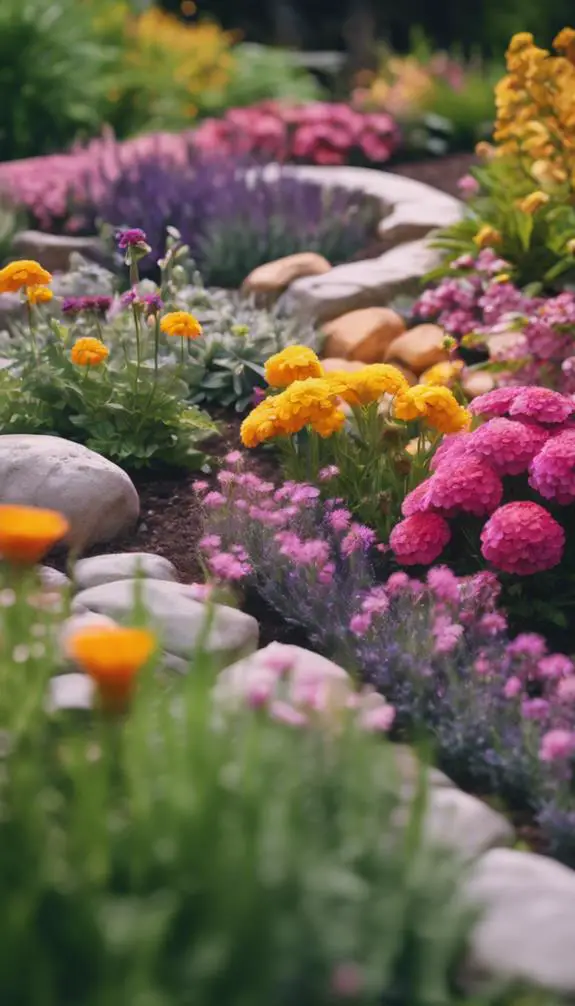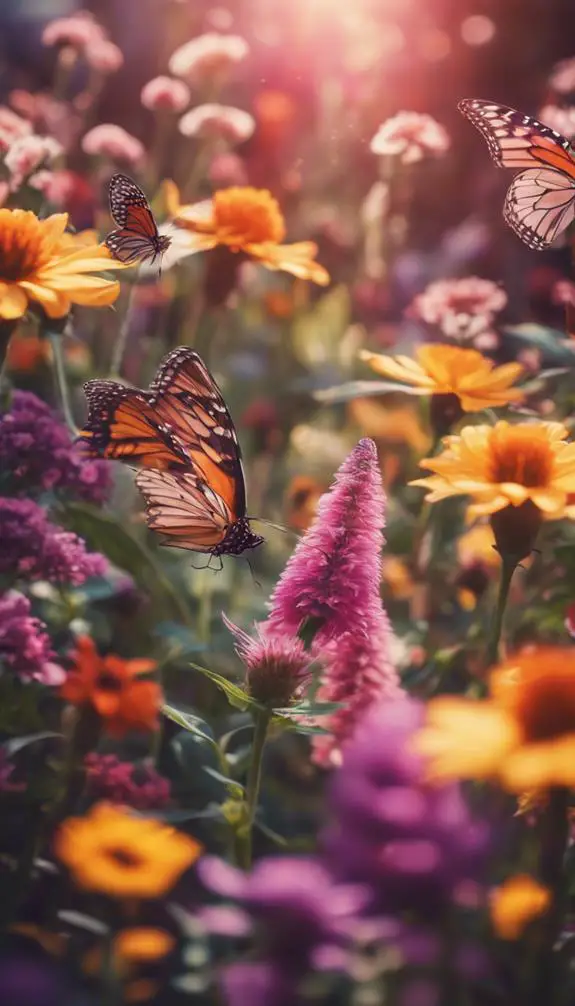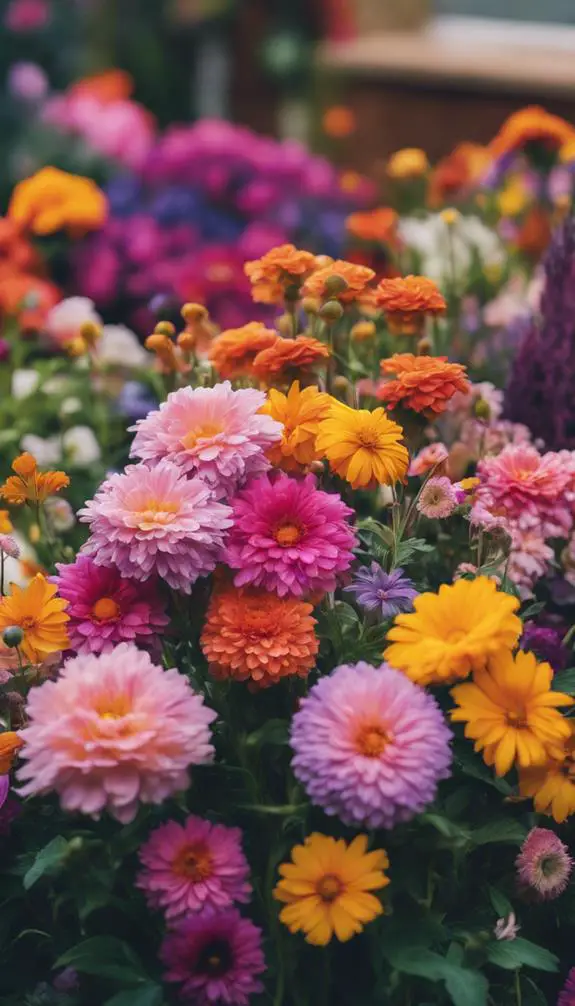As you plan your garden, you're likely looking for ways to create a vibrant display of color that lasts from the first signs of spring to the final days of fall. Perennial flowers that bloom throughout the growing season are the perfect solution, offering a dynamic display of color and texture that changes with the seasons. From early spring blooms to autumn stunners, these flowers provide continuous interest in the garden. But which ones should you choose?
Summary
- Coneflowers and Black-Eyed Susans bloom from mid-summer to fall, while also tolerating full sun and drought.
- Crocus and Grape Hyacinth burst forth with colorful blooms as early as February, starting the spring season.
- Asters and Chrysanthemums create a stunning display of color that lasts well into the fall season.
- Catmint and Sedum offer continuous blooms from spring to fall, making them perfect for container combos.
- By choosing perennials with staggered bloom times, you can create a garden that blooms from spring to fall with minimal maintenance.
Bee-Friendly Perennials for Spring

As you gear up for spring, consider giving your local bee population a helping hand by planting bee-friendly perennials in your garden.
These Early Risers will provide a much-needed source of nectar and pollen for hungry bees emerging from hibernation. Some top picks for Spring Awakeners include Crocus, Grape Hyacinth, and Winter Aconite, which burst forth with colorful blooms as early as February.
These low-maintenance perennials thrive in well-draining soil and full sun to partial shade, making them perfect for gardens of all sizes. By incorporating these bee-friendly perennials into your garden, you'll not only support local pollinators but also add vibrant color and texture to your outdoor space.
Summer Blooms in Shade

While bee-friendly perennials get the garden off to a vibrant start in spring, your shade gardens don't have to wait until summer to burst into bloom.
You can create a stunning summer display with shade-loving plants that thrive in low-light conditions. Summer flowering shrubs like Hydrangea and Weigela provide vibrant blooms in shades of pink, blue, and white.
Astilbe, with its feathery plumes, adds a delicate touch to the garden. Hostas, with their large leaves, provide a beautiful backdrop for summer blooms.
Drought-Tolerant Flowers for Heat

When you're selecting perennials for hot, dry areas, you'll want to focus on heat-resistant flower options that can thrive in temperatures above 85°F (30°C).
Look for varieties that can survive with minimal watering, as they'll be more resilient to drought conditions. By choosing low-water flowers, you'll reduce your water consumption and create a sustainable garden that requires minimal maintenance.
Heat-Resistant Flower Options
Many perennial flowers struggle to thrive in scorching temperatures, but several varieties have adapted to beat the heat.
You'll find heat-resistant flowers in desert blooms, like the Desert Marigold, which blooms from February to May, and the Globe Mallow, which produces bright orange flowers from March to May.
Tropical flowers, such as the Hibiscus and the Mandevilla, also thrive in hot climates.
These flowers have developed mechanisms to conserve water and protect themselves from intense sunlight.
For instance, the Desert Marigold has thick, hairy leaves that reduce water loss, while the Hibiscus has large, thin leaves that provide shade and cooling.
Low Water Flower Needs
You'll often find that drought-tolerant flowers are a natural fit for hot climates, as they've evolved to conserve water and thrive in dry conditions.
These flowers have adapted to survive with minimal water, making them ideal for water-wise gardens and Xeriscape designs. When selecting low-water flowers, look for plants with deep roots, small leaves, or waxy coatings that prevent water loss.
Succulents, sedums, and yarrow are excellent options, as they're highly resistant to drought. By incorporating these flowers into your garden, you'll not only reduce your water consumption but also create a beautiful, resilient landscape that can withstand the heat.
Vibrant Perennials for Cut Gardens

Cut flower gardens burst with color and vibrancy when featuring perennials specifically chosen for their cutting potential.
You'll want to select varieties that not only provide an abundance of blooms but also retain their beauty when cut and arranged. Consider incorporating perennials like peonies, delphiniums, and cosmos into your garden design elements.
These flowers are perfect for creating stunning cut flower arrangements that will elevate your home decor. When designing your cut garden, remember to group plants by bloom time and color to guarantee a constant supply of fresh stems.
Low-Maintenance Border Flowers

Perennials selected for low-maintenance border flowers should prioritize hardiness, disease resistance, and pest tolerance, allowing them to thrive with minimal upkeep.
Before planting, you'll want to focus on border prep and soil conditioning to create a favorable environment. Remove weeds and debris, then till the soil to a depth of 8-10 inches to loosen and aerate it.
Add organic matter like compost or well-rotted manure to improve soil structure and fertility. This will give your perennials a strong foundation to grow from.
Attracting Butterflies to Gardens

As you design your low-maintenance border, consider extending its appeal to another dimension by attracting butterflies to your garden.
By incorporating butterfly magnets, you'll create a haven for these delicate creatures. Plant fragrant nectar sources like butterfly bush, lantana, and coneflower, which will draw them in with their sweet aromas.
Incorporate a mix of native wildflowers, herbs, and shrubs that provide shelter and host plants for caterpillars. Aim for a diverse selection of blooms that provide a constant nectar supply from spring to fall.
Perennials for Moist Soil Conditions

Moist soil conditions can be a blessing in disguise, allowing you to cultivate a unique palette of perennials that thrive in these environments.
You'll find that river plants like Cardinal Flower and Marsh Flowers like Blue Flag Iris love the constant moisture. These perennials are adapted to survive in wet conditions, making them ideal for areas with standing water or poor drainage.
By incorporating these plants into your garden, you'll create a lush oasis that's teeming with life. Plus, they'll provide a stunning display of color and texture throughout the growing season.
With the right selection of perennials, you can turn a potentially problematic area into a stunning feature.
Fall Color With Asters and More
While you're enjoying the lush oasis created by perennials that thrive in moist soil, you're likely already thinking about how to extend the colorful display into the fall season.
Asters, with their daisy-like flowers, are a great choice for adding autumn hues to your garden. These perennials come in a variety of species, such as the New England aster and the Italian aster, and bloom from late summer to early fall.
Other perennials, like chrysanthemums and sedum, also provide vibrant fall foliage. By incorporating these flowers into your garden, you can create a stunning display of color that will last well into the fall season, adding depth and interest to your landscape.
Continuous Bloomers for Containers

Creating a container garden that blooms continuously can be a challenge, but with the right perennials, you can achieve a vibrant display of color throughout the growing season.
To create a seamless bloom sequence, focus on Container Combos that pair plants with staggered bloom times. For example, combine spring-blooming creeping thyme with summer-blooming catmint and fall-blooming sedum.
This strategy guarantees that as one plant finishes blooming, another takes its place.
Consider Seasonal Swaps to refresh your container garden throughout the year. Simply replace spent plants with new ones to maintain a dynamic display of color.
Perennials for Full Sun Exposure

You're looking for perennials that thrive in full sun exposure, and you've come to the right place.
When selecting perennials for areas receiving six or more hours of direct sunlight, you'll want to focus on drought-tolerant options that can withstand high temperatures.
You'll find vibrant color choices among perennials like coneflowers, black-eyed susans, and salvias that not only tolerate full sun but also attract pollinators and add visual interest to your garden.
Drought Tolerant Options
Five to six hours of direct sunlight daily can be challenging for perennials, but many drought-tolerant options thrive in full sun exposure.
You'll find Water Storers, like coneflowers and black-eyed susans, that store water in their roots, stems, or leaves to survive dry spells.
Succulent Beauties, such as sedum and yarrow, have adapted to conserve water by developing thick, fleshy leaves or stems.
These perennials require minimal watering, making them perfect for areas with low rainfall or water restrictions.
Vibrant Color Choices
Across full sun exposures, a kaleidoscope of vibrant colors unfolds as perennials burst into bloom, painting the landscape with an artist's palette of hues.
You'll find perennials that thrive in full sun exposure, offering a diverse range of color schemes to elevate your garden's aesthetic.
Consider pairing warm-seasonal hues like orange and yellow with cool-seasonal shades of blue and purple to create a visually striking contrast.
As you plan your garden, remember to balance bold, bright colors with softer, pastel shades to avoid visual overwhelm.
Fragrant Flowers for Sensory Delight

The allure of fragrant flowers is undeniable, and incorporating them into your perennial garden can elevate the sensory experience for you and your visitors.
You'll find that fragrant flowers add a new dimension to your garden, enticing you to linger and savor the scents.
Scented petals of flowers like roses, freesias, and lavender release their fragrance as you brush against them, while others, like peonies and gardenias, emit a sweet aroma from their fragrant hues.
By selecting a mix of fragrant perennials that bloom at different times, you can create a sensory experience that unfolds throughout the growing season.
This thoughtful approach will enhance your garden's ambiance and make it a true delight for the senses.
Deer-Resistant Perennials for Gardens

As you design your perennial garden, you'll want to ponder deer-resistant options to protect your investment from these pesky critters.
You can choose from a variety of deer-repellent plant options, install fencing to deter deer, or select specific flower types that deer tend to avoid.
Deer-Repellent Plant Options
With deer populations on the rise, homeowners and gardeners alike are seeking effective ways to protect their gardens from these hungry critters.
You can create a deer-repellent garden by incorporating plants that deer find unpalatable. Deer deterrent plants like lavender, rosemary, and sage are known to repel deer due to their strong scents and tastes.
Planting these species around the perimeter of your garden can help deter deer from entering. You can also intermingle deer-repellent plants with your desired perennials to create a repellent garden.
Another option is to use plants with prickly or fuzzy leaves, like lamb's ear or mullein, which deer tend to avoid.
Deter Deer With Fencing
Incorporating deer-repellent plants into your garden design is just one part of the solution.
To fully deter deer, you'll need to combine these plants with effective fencing. When choosing deer fencing materials, consider durable options like metal mesh, wood, or plastic.
For ideal results, certify your fence is at least 8 feet tall and extends at least 12 inches below ground to prevent digging. Garden fencing tips include installing the fence at a 45-degree angle to prevent deer from jumping, and using a single strand of electric wire to deter them from attempting to jump.
Proper fencing will help protect your deer-resistant perennials and give you peace of mind. By combining these strategies, you'll be well on your way to a thriving, deer-free garden.
Deer-Resistant Flower Types
You'll find a diverse range of deer-resistant flower types that can add beauty and resilience to your garden.
These Resistant varieties are specifically bred to deter deer from feeding on them, making them ideal for deer proof gardens. Look for flowers with strong scents, bitter tastes, or prickly textures, which deer tend to avoid.
Some popular options include lavender, coneflower, and black-eyed Susan. These flowers aren't only unappealing to deer but also attract beneficial pollinators like bees and butterflies.
Easy-to-Grow Perennials for Beginners

As a beginner, selecting the right perennials can be intimidating, especially when faced with the vast array of options available.
However, by understanding easy care tips and avoiding common beginner mistakes, you can successfully grow perennials that thrive from spring to fall.
Start by choosing perennials that are low maintenance and disease-resistant.
Some excellent options include coneflowers, black-eyed Susans, and catmint.
These flowers are hardy, require minimal pruning, and can tolerate dry spells.
When planting, make sure to provide adequate sunlight and water them regularly during the first growing season.
Avoid overwatering, which can lead to root rot, and don't overcrowd your plants, as this can encourage the spread of disease.
FAQs
Can Perennial Flowers Be Grown in Containers on a Balcony or Patio?
You can grow perennial flowers in containers on your balcony or patio, but guarantee you choose a container size that accommodates the mature plant's root system, and consider balcony decor that provides adequate sunlight and drainage for ideal growth.
Do Perennial Flowers Require Deadheading to Promote Continuous Blooming?
You'll find that deadheading indeed boosts blooming frequency, as removing spent flowers encourages plants to redirect energy towards producing new blooms, thereby increasing flower longevity and overall flowering duration.
Can I Plant Perennial Flowers in the Fall for Spring Blooms?
You can plant perennials in the fall for spring blooms, taking advantage of fall's cooler temperatures for ideal root growth; focus on cool-season varieties, and prepare soil properly for a successful fall planting.
How Often Should Perennial Flowers Be Watered During Hot Summer Months?
During hot summer months, you should water perennial flowers when the top 2-3 inches of soil feel dry to the touch, ensuring soil moisture levels are maintained to prevent summer drought stress, which can lead to flower bud drop.
Do Perennial Flowers Need to Be Fertilized Annually for Optimal Growth?
You should fertilize annually for ideal growth, but first, you'll want to conduct soil testing to determine nutrient deficiencies; then, consider foliar feeding to provide a quick nutrient boost, as it can be more effective than traditional fertilization methods.
Conclusion
By incorporating perennials that bloom from spring to fall, you'll create a dynamic display of color throughout the growing season. With a mix of bee-friendly, shade-tolerant, drought-resistant, and fragrant flowers, you'll attract pollinators, thrive in challenging conditions, and delight your senses. Whether you're a beginner or an experienced gardener, these perennials will provide continuous interest in your garden, ensuring a kaleidoscope of colors and textures from February to November.




